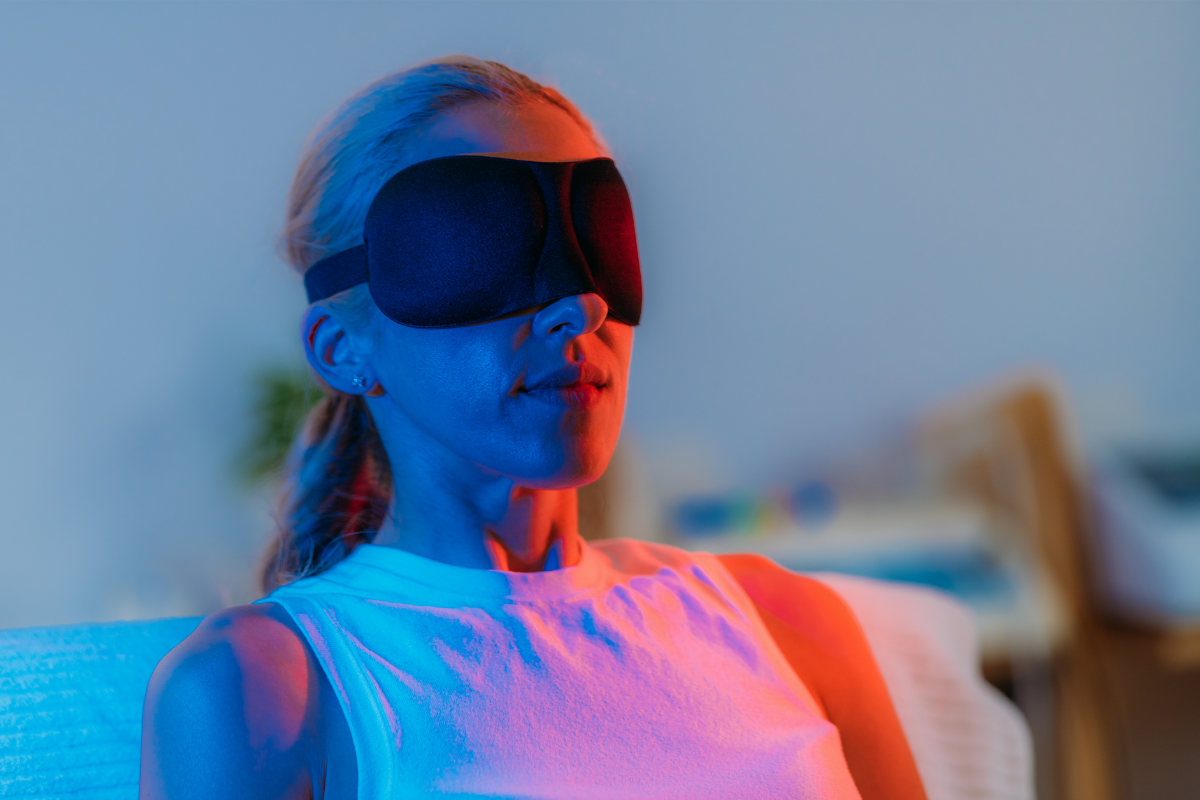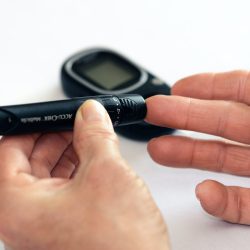Insulin resistance is a major public health concern. Recent studies suggest that exposure to red light or‘red light therapy‘ could play a significant role in regulating blood sugar levels. This article will look in detail at these findings and the potential mechanisms at work.
What is insulin resistance?
Insulin resistance is a condition in which the body’s cells become less sensitive to the action of insulin. This results in an accumulation of glucose in the blood, posing an increased risk of developing diabetic complications.
Causes
There can be many causes, ranging from genetic factors to unhealthy lifestyle habits.
Symptoms
Symptoms can include chronic fatigue, weight gain and excessive thirst.
Current treatments
At present, treatment is often based on blood glucose-lowering medication and lifestyle changes such as diet and exercise.
Can red light lower blood sugar levels?
Exposure to red light at a wavelength of 670 nm has been shown to be a promising clinical intervention for regulating blood sugar levels. Studies have indicated that this non-invasive technique could have a significant impact on biochemical and metabolic mechanisms, particularly in the management of diabetes and glucose-related disorders.
Underlying biochemical mechanisms
The impact of 670 nm red light on blood glucose levels is mainly attributed to its role in modulating ATP levels. Studies have shown that this light increases mitochondrial oxidative phosphorylation, leading to an increase in ATP levels. The increase in ATP in turn promotes better diffusion of glucose into the cells, contributing to a reduction in blood glucose levels.
In addition, it is important to note that red light at 670 nm could also stimulate the incorporation of glucose into carbohydrate stores, although this mechanism requires further study.
Recent clinical results
Recent research has shown that exposure to 670 nm red light 45 minutes before a glucose tolerance test significantly reduced post-prandial glucose levels. This reduction is particularly beneficial for people with impaired glucose homeostasis, as prolonged high blood glucose levels can lead to inflammation and insulin resistance in vascular endothelial cells.
The effect of this red light has been observed in various species, and significant changes have been noted in the expression of cytokines in the blood. These changes could also play a role in the regulation of glycaemia on a systemic scale.
Potential clinical applications
The impact of 670 nm red light on blood glucose regulation opens the way to new interventions for the management diabetes and pre-diabetes. Studies indicate that exposure to this light could reduce post-prandial glucose fluctuations, which increase the risk of diabetes-related complications such as nephropathy, retinopathy and cardiovascular disease.
How could red light regulate blood sugar levels?
The regulation of blood sugar levels is a major issue in endocrinology and in the treatment of metabolic conditions such as type I and type II diabetes, as well as pre-diabetes. Prolonged elevation of blood glucose levels can lead to various complications, including inflammation and insulin resistance in vascular endothelial cells.
Underlying biochemical mechanisms
The effect of 670 nm red light on glucose regulation can be attributed to several biochemical mechanisms. The most notable is the increase in adenosine triphosphate (ATP)levels by stimulating oxidative phosphorylation at the mitochondrial level. This bioenergetic activation facilitates the diffusion of glucose into the cells, responding to increased intracellular demand. As a result, there is a significant reduction in circulating glucose levels, which may be beneficial in controlling post-prandial hyperglycaemia and minimising glycaemic fluctuations.
Clinical and experimental studies
Recent studies have corroborated the consistency of the effect of 670 nm red light on blood glucose levels across different species, reinforcing its applicative potential. However, the the onset time of this effect requires further investigation. In the studies conducted, exposure to red light was carried out 45 minutes before administration of the glucose tolerance test. The results show a significant reduction in blood glucose levels 45 minutes after the test.
Clinical significance and future areas of research
Since exposure to 670 nm red light appears to have beneficial effects on blood glucose levels, it could be incorporated into clinical interventions for patients with blood glucose disorders. However, a number of questions remain unanswered: What is the optimal duration of exposure to red light? How effective is it in combination with other drug treatments or dietary interventions? In addition, further studies are needed to elucidate the precise mechanisms by which red light acts on glucose regulation, particularly with regard to variations in the levels of cytokines and other biochemical mediators.
Other recognised benefits of red light and near infrared light
Beyond its promising role in regulating blood sugar levels, red light and near infrared light offer other substantial benefits, validated by scientific research:
Improved skin health
Red light is renowned for its beneficial effects on skin health. It stimulates collagen production, helping to reduce the signs of ageing, such as fine lines and wrinkles (1). It also promotes healing and can be effective in treating conditions such as acne, rosacea (2), scars (3) and stretch marks.
Reduced inflammation and pain
Studies have shown that exposure to red light can reduce inflammation and pain, particularly in cases of arthritis, muscle pain and other inflammatory conditions (4). This is due to the light’s ability to penetrate deep into tissues, improving blood circulation and speeding up repair processes.
Support for mental health
NIR has also been associated with mental health benefits. It has been suggested that this light can help reduce symptoms of depression and anxiety, notably by increasing cerebral blood flow and stimulating neuronal activity (6).
Improving sports performance and recovery
Red light is increasingly used by athletes to improve performance and speed up muscle recovery after exercise. It helps to reduce muscle soreness and accelerate tissue repair, leading to faster recovery and improved physical performance.
Effects on eye health
Exposure to near-infrared light can benefit eye health. Research suggests that this light may help prevent or slow down age-related macular degeneration by improving mitochondrial function in retinal cells (5).
What food supplements can help lower blood sugar levels?
Controlling blood sugar levels is a major concern for people with diabetes and even for those with pre-diabetes. While lifestyle modifications and prescribed medication remain fundamental approaches, dietary supplements are emerging as a complementary option, backed by science.
Scientific basis
Studies have highlighted the effectiveness of various food supplements in regulating blood sugar levels. For example, berberine, a compound found in several plants, has shown similar efficacy to metformin, a drug commonly used for type 2 diabetes. Alpha-lipoic acid, a powerful antioxidant, has also shown promising signs of improving insulin sensitivity.
Ease of integration
One of the advantages of food supplements is that they are easy to incorporate into your daily routine. They generally come in the form of capsules, tablets or powders that can be easily incorporated into your diet.
Safety and minimal side effects
Many dietary supplements for blood sugar regulation are derived from natural sources and have a minimal side-effect profile compared with prescription drugs, of course after medical consultation to ensure they are suitable for your personal situation.
Complementing other therapies
Food supplements can be used to support other forms of treatment, including innovative interventions such as exposure to 670 nm red light, which has also been shown to have beneficial effects on blood sugar regulation.
FAQ
What is 670 nm red light?
Red light at 670 nm is a specific wavelength of light that has been shown by several scientific studies to have beneficial effects on blood sugar regulation.
How does red light at 670 nm affect glucose levels?
Studies have shown that exposure to this light increases mitochondrial oxidative phosphorylation, leading to an increase in ATP levels. This mechanism promotes better diffusion of glucose into cells, which helps to reduce blood glucose levels.
What is the link between red light and mitochondria?
Mitochondria, often referred to as the ‘energy powerhouses’ of cells, play a key role in ATP production. Red light at 670 nm is known to increase the efficiency of oxidative phosphorylation in mitochondria, thereby increasing ATP levels.
Is this therapy applicable to all types of diabetes?
Although more research is needed, current studies suggest that red light at 670 nm could be beneficial for the management of type I and type II diabetes as well as pre-diabetes.
How does this therapy fit into a treatment plan for diabetes?
Exposure to 670 nm red light can be considered as a complementary intervention in an overall treatment plan for diabetes, which may include medication, a balanced diet and exercise.
Are there any side effects?
Research into red light at 670 nm has not shown any serious side effects to date. However, it is always advisable to consult a healthcare professional before starting any new form of treatment.
How long does it take to see results?
In clinical studies, a significant reduction in glucose levels was observed 45 minutes after exposure to red light. However, the time needed to see results may vary from one individual to another.
Is 670 nm red light effective at other times of the day?
Studies have shown that the rate of mitochondrial oxidation is at its peak in the morning, which coincides with the maximum effectiveness of red light at 670 nm.
Source:
- (1) https://pubmed.ncbi.nlm.nih.gov/15654716/
- (2) https://pubmed.ncbi.nlm.nih.gov/19764893/
- (3) https://pubmed.ncbi.nlm.nih.gov/11776448/
- (4) https://pubmed.ncbi.nlm.nih.gov/36599881/
- (5) https://www.ucl.ac.uk/news/2021/nov/morning-exposure-deep-red-light-improves-declining-eyesight
- (6) https://pubmed.ncbi.nlm.nih.gov/26989758/
- https://www.researchgate.net/publication/373466102_Optical_stimulation_of_mitochondria_reduces_blood_glucose_levels
- https://www.ncbi.nlm.nih.gov/pmc/articles/PMC9632789/
@soin.et.nature ✨️Metarecod sachets-dose de granulés contribue au traitement du syndrome métabolique et pour le rééquilibrage d’un ou plusieurs paramètres métaboliques altérés: cholestérol – triglycérides – glycémie ✨️Produit disponible sur www.soin-et-nature.com #soinetnature #glycemie #diabete #diabetes #ldl #hdl #cholesterol #fatloss #cheapremedy #natureltreatmentcholesterol #naturaltreatmentdiabetes #conseil #astuce #botox #sante #avene #bioderma #antiage #acidehyaluronique #vitaminec #argireline #medecineesthetique #jeuneintermittent #bodyrecomp #recompositioncorporelle #prisedemasse #naturopathie #glutathion #sante #metabolisme #syndromemetabolique #shiitake #nhco #biocyte #naturactive #aboca #pharmacieenligne #onlinepharmacy #otc #otcdiabetes #fyp #pourtoi





